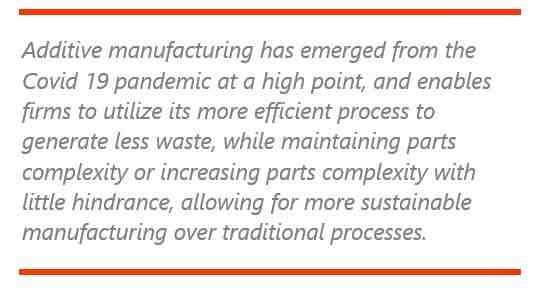

Additive manufacturing – industrialized 3D printing – has emerged from several challenges in the past few years and has become a viable part of the manufacturing industry. As businesses pivot towards digital transformation frameworks  to overhaul their operations, and with a growing concern about the environment as well, additive manufacturing is now being recognized as a sustainable alternative to traditional manufacturing methods. Additive manufacturing demonstrated its ability to adapt to shrinking supply chains in the face of a global crisis and allow local facilities to print supplies they would otherwise have to wait months for.
to overhaul their operations, and with a growing concern about the environment as well, additive manufacturing is now being recognized as a sustainable alternative to traditional manufacturing methods. Additive manufacturing demonstrated its ability to adapt to shrinking supply chains in the face of a global crisis and allow local facilities to print supplies they would otherwise have to wait months for.
Coming out of COVID, additive manufacturing benefits sustainability through a material advantage in terms of processing and use, coupled with its ability to print custom parts of a better quality in a more efficient process, and its ability to print on demand have made it absolutely game changing for firms. As industry seeks to reform and transition itself to a more sustainable standard to comply with regulatory and compliance needs, and as the market shifts its attention to reducing environmental impact, additive manufacturing will continue to grow as a recurrent choice for sustainable manufacturing.
Key findings include:
Additive manufacturing saw a rough transition during FY 2019 to 2020 when the pandemic began. Overall, revenue generation across most industries fell, with returned projections showing growth stalled or in some cases receding; and overall revenues much less than envisaged future projections. Asia, followed by Europe, North America, and the rest of the world went into lockdowns and travel restrictions, limiting the ability for industries to produce vitally needed goods across all market sectors. Just-in-time production, a staple of economies since the 1980s, had fallen short amid the lockdowns.
People forced into a work from home situation had also spurred on a huge demand for dwindling supplies across multiple industries, and medical workers battling with COVID were experiencing shortages in very vital personal protective equipment. With these problems in mind, industries began searching for methods to shore up supply chain shortages or refine their products to make use of what was available. Enter here, 3D printing.
3D printing and the concept of additive manufacturing as a whole gained ground during the pandemic, starting with frontline medical workers. Multiple schools and hospitals released designs for 3D printable personal protective equipment. The United States Food and Drug Administration and the National Institute of Health released guides and pooled these resources to make these designs more accessible to healthcare professionals. It worked - 3D printed designs began to act as stop gaps for traditional respirators and half face masks, both in the medical sector and for civilian use.
ARC Advisory Group clients can view the complete report at ARC Client Portal
If you would like to buy this report or obtain information about how to become a client, please Contact Us

